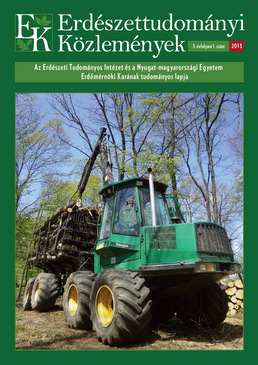| 1. | Abaigar, T. 1992: Paraméters de la reproduction chez le sanglier (Sus scrofa) dans le sud-est de la péninsule iberique. Mammalia, 56(2): 245–250. DOI: 10.1515/mamm-1992-0208 |
| 2. | Ahmad E., Brooks J. E., Hussain I. and Khan M. H. 1995: Reproduction in Eurasian wild boar in central Punjab, Pakistan. Acta Theriologica, 40 (2):163–173. DOI: 10.4098/at.arch.95-17 |
| 3. | Ahrens, M. 1984: A study on wild boar reproduction. Beitr. Jagd-Wildforsch., 13: 231–243. |
| 4. | Andrzejewski, R. and Jezierski, W. 1978: Management of a wild boar population and its effects on commercial land. Acta Theriologica, 23: 309–339. DOI: 10.4098/at.arch.78-23 |
| 5. | Aumaitre, A., Quere, J. P. and Peiniau, J. 1984: Influence du milieu sur la reproduction hivernale et la prolificité de la laie. Reproduction and prolificacy of European wild sow in France: effect of location and nutritional conditions.) – In: INRA Publ. (Ed.); Symposium international sur la Sanglier, Toulouse, France, pp. 69–78. |
| 6. | Bieber, C. and Ruf, T. 2005: Population dynamics in wild boar Sus scrofa: ecology, elasticity of growth rate and implications for the management of pulsed resource consumers. Journal of Applied Ecology, 42(6): 1203–1213. DOI: 10.1111/j.1365-2664.2005.01094.x |
| 7. | Boisaubert, B. and Klein, F. 1984: Contribution á l’étude de l’occupation de l’espace chez le sanglier (Sus scrofa) par capture et recapture. In: INRA Publ. (Ed.); Symposium international sur la Sanglier, Toulouse, France, 135–150. |
| 8. | Boitani, L.; Trapanese, P. and Mattei, L. 1995: Demographic patterns of a wild boar (Sus scrofa L.) population in Tuscany, Italy. Journal of Mountain Ecology 3: 197–201. |
| 9. | Briedermann, L. 1971: Zur Reproduktion des Schwarzwildes in der Deutschen Demokratische Republik. Tag. Ber. Akad. Landwirtsch. Wiss. Berlin., 113: 169–186. |
| 10. | Ditchkoff S. S., Jolley D. B., Sparklin B. D., Hanson L. B., Mitchell M. S. and Grand J. B. 2012: Reproduction in a Population of Wild Pigs (Sus scrofa) Subjected to Lethal Control. The Journal of Wildlife Management, 76(6): 1235–1240. DOI: 10.1002/jwmg.356 |
| 11. | Fernández-Llario P. and Mateos-Quesada P. 1998: Body size and reproductive parameters in the wild boar Sus scrofa. Acta Theriologica, 43(4): 439–444. DOI: 10.4098/at.arch.98-54 |
| 12. | Gaillard, J-M.; Brandt, S. and Jullien, J-M. 1993: Body weight effect on reproduction of young wild boar (Sus scrofa) females: a comparative analysis. Folia zoologica, 42(3): 204–212. |
| 13. | Gaillard, J.-M. ; Vassant, J. and Klein, F. 1987: Quelques caractéristiques de la dynamique des populations de sangliers (Sus scrofa) en milieu chassé. Some characteristics of the population dynamics of wild boar (Sus scrofa scrofa) in a hunted environment.) Gibier Faune Sauvage, 4: 31–47. |
| 14. | Garzon-Heydt, P. 1992: Study of a population of wild boar Sus scrofa castillianus Thomas, 1912 in Spain, based on hunting data. Global trends in wildlife management. Transactions of the 18th Congress of the IUGB, Krakow, Poland 2: 489–492. |
| 15. | Groot Bruinderink, G.V.T. & Hazebroek, E. 1994: Diet and condition of wild boar, Sus scrofa, without supplementary feeding. Journal of Zoology, 233: 631–648. DOI: 10.1111/j.1469-7998.1994.tb05370.x |
| 16. | Habermehl, K-H. 1985: Alterbestimmung bei Wild- und Pelztieren. Verlag Paul Parey, Hamburg-Berlin |
| 17. | Heltay I.; Mátrai G.; Sugár L. és Kovács I. 1981: A vaddisznó szaporodási vizsgálata disznóskertben és szabad területen. Nimród Fórum, 9: 18–23. |
| 18. | Jezierski, W. 1977: Longevity and mortality rate in a population of wild boar. Acta Theriologica, 22: 337–348. DOI: 10.4098/at.arch.77-31 |
| 19. | Kőhalmy T. 1979: Adatok a vaddisznóállomány értékeléséhez. Nimród Fórum 24(9). |
| 20. | Linderoth, P. 2010: Energieversorgung und Reproduktion einer Schwarzwildpopulation. Wildforschung in Baden-Württemberg (9) Schwarzwildseminar in der Schwäbischen Bauerschule. |
| 21. | Martys, M. 1982: Gehegebeobachtungen zur Geburts- und Reproduktionsbiologie des Europäischen Wildschweines (Sus scrofa). Zeitschrift für Säugetierkunde, 42: 100–113. |
| 22. | Mauget, R. 1972: Observations sur la reproduction du sangiler (Sus scrofa) a l état sauvage. Observations on wild-pig (Sus scrofa L.) reproduction.). Annales de Biologie animale, Biochimie, Biophysique, 12(2): 195–202. DOI: 10.1051/rnd:19720201 |
| 23. | Mauget, R. 1980: Regulations ecologiques comportementales et physilogiques (fonction de reproduction de l’adaptation du sanglier Sus scrofa L. au milieu . C.N.C.R. |
| 24. | Melis, C.; Szafranska, P.A.; Jedrzejewska, B. and Barton, K. 2006: Biogeographical variation in the population density of wild boar (Sus scrofa) in western Eurasia. Journal Biogeography, 33: 803–811. DOI: 10.1111/j.1365-2699.2006.01434.x |
| 25. | Merta, D.; Albrycht, M.; Frackowiak, W.; Furtek, J. and Mamok, T. 2011: Reproductive parameters, birth date-effect and body condition of wild boars (Sus scrofa) inhabiting forest and forest-farmland environments in Poland. 8th European Vertebrate Pest Management Conference, 233–234. |
| 26. | Faragó S. és Náhlik A. 1997: A vadállományok szabályozása, Mezőgazda Kiadó, p. 263. |
| 27. | Pedone, P.; Mattioli, L.; Mattioli, S.; Siemoni, N.; Lovari, C. and Mazzarone, V. 1991: Body growth and fertility in wild boars of Tuscany, Central Italy. In: Csányi, S. and Ernhaft, J. (eds.); Transactions of the XXth Congress of the IUGB. Gödöllő, Hungary, 604–609. |
| 28. | Sáez-Royuela, C. and Tellería, J.L. 1987: Reproductive trends of the wild boar (Sus scrofa) in Spain. Folia Zoologica, 36: 21–25. |
| 29. | Spitz, F. 1992: General model of the spatial and social organization of the Wild Boars (Sus scrofa L.). In: Spitz, F.; Janeau, G.; Gonzales, G. and Aulagnier, S. (eds.); Proceedings of the International Symposium „Ongulés / Ungulates 91” Toulouse-France. 385–389. |
| 30. | Vericad, R. 1983: Estimacion de la edad fetal y periodos de conception y parto del jabali (Sus scrofa) en los Pirineos occidentalis. In: Acta del XV. Congreso Int. Fauna Cinegetica y Silvestre 1981. pp. 811–820. |
| 31. | de Vos, von A. and Sassani, A. 1977: Eine Studie der Population des Schwarzwildes (Sus scrofa) in dem Mohammad Reza hah Nationalpark. A wild boar (Sus scrofa) population study in Mohammad Reza Shah National Park). Zeitschrift für Jagdwissenschaft, 23: 113–125. |
